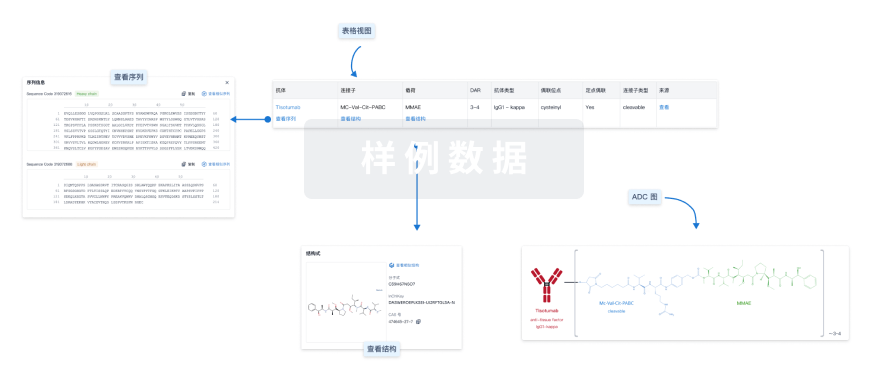预约演示
更新于:2025-12-06
212Pb-NG001
更新于:2025-12-06
概要
基本信息
药物类型 多肽偶联核素、治疗用放射药物 |
别名 Pb212-NG001、AB001 |
靶点 |
作用方式 抑制剂 |
作用机制 PSMA抑制剂(前列腺癌特异性膜抗原抑制剂)、电离辐射发射源 |
在研适应症 |
非在研适应症- |
原研机构 |
在研机构 |
非在研机构- |
最高研发阶段临床1期 |
首次获批日期- |
最高研发阶段(中国)- |
特殊审评- |
登录后查看时间轴
结构/序列
使用我们的ADC技术数据为新药研发加速。
登录
或

关联
2
项与 212Pb-NG001 相关的临床试验NCT07214961
Study to Investigate the Safety, Tolerability, Pharmacokinetics, Biodistribution and Antitumour Activity of the Alpha Radioligand Therapy AB001 in Patients With Metastatic Castration Resistant Prostate Cancer
This Phase 1 study will evaluate the safety, tolerability, and preliminary effectiveness of AB001, an alpha-emitting radioligand targeting prostate-specific membrane antigen (PSMA), in patients with advanced prostate cancer who are either 177Lu-PSMA naïve or experienced. The study includes dose escalation to identify a recommended dose and dose expansion to further assess safety and anti-tumour activity. Primary objectives are to characterize the safety profile and determine the optimal dose and schedule for future studies
开始日期2025-11-03 |
申办/合作机构 |
NCT05725070
Phase 0/1 Theragnostic Study in Patients With Metastatic Castration Resistant Prostate Cancer in Need of Salvage Therapy, Selected by 18F-PSMA-PET Imaging and Treated by Alpha-therapeutic Radioligand 212Pb-NG001
The purpose of this study is to evaluate the imaging feasibility and safety of 212Pb-NG001.
开始日期2023-03-06 |
申办/合作机构 |
100 项与 212Pb-NG001 相关的临床结果
登录后查看更多信息
100 项与 212Pb-NG001 相关的转化医学
登录后查看更多信息
100 项与 212Pb-NG001 相关的专利(医药)
登录后查看更多信息
1
项与 212Pb-NG001 相关的文献(医药)2023-01-01·Nutrition and metabolic insights
Impact of a Single Dose of a Probiotic Nutritional Supplement (AB001) on Absorption of Ethylalcohol: Results From a Randomized Double-Blind Crossover Study
Article
作者: de Faire, Johan ; Demircik, Filiz ; Pfützner, Anke ; Wittig, Tobias ; Hanna, Mina ; Sachsenheimer, Daniela ; Pfützner, Andreas
Background::
We conducted a prospective placebo-controlled double-blind randomized Study to assess the impact of a single dose of a nutritional Supplement (AB001) on alcohol absorption in healthy subjects. Other objectives were the impact on breath alcohol content, cognitive function 1 hour after alcohol uptake and tolerability.
Method::
A total of 24 healthy volunteers were enrolled into the study (12 male, 12 female, age: 28.3 ± 10.8 years, BMI: 23.5 ± 5.7 kg/m²). On the experimental day, they ingested a light breakfast together with a single dose (2 capsules) of AB001 (or placebo) and drank 2 moderate glasses of spirit (a total of 0.6 g/kg body weight). Breath alcohol tests and blood draws for determination of blood alcohol levels were performed for up to 6 hours. After crossover, the experiment was repeated in the following week. Areas under the curves were calculated to determine alcohol absorption rates.
Results::
There was a significant reduction of blood alcohol by 10.1% ( P < .001) with AB001, when compared to placebo. There was a less pronounced but also significant reduction of alcohol in the breath test by 7.2% ( P < .05). No difference in the cognitive function test between AB001 and placebo could be observed 60 minutes after alcohol ingestion (22.6 ± 8.0 seconds vs 23.0 ± 11.2 seconds, n.s.). The supplement uptake was well tolerated and there were no adverse events related to the study intervention.
Conclusion::
Uptake of a single dose of AB001 shortly before drinking alcohol significantly reduced plasma alcohol and breath alcohol concentrations, but the effect was less pronounced compared to chronic uptake as shown previously.
35
项与 212Pb-NG001 相关的新闻(医药)2025-11-10
·科Way
寒冬冰封的生物医药赛道
已出现了复苏迹象
现在正是孕育未来健康黄金赛道的绝佳时机
靶向核药、类器官
脑机接口、合成生物学
最新一期《浦东科技》杂志
为你勾勒未来健康产业
从实验室到产业化再到临床应用的路线图
点击文末“阅读原文”
即可打开最新一期《浦东科技》杂志
【锋面】
《瞄准、发射、击破!》
随着我国核药顶层设计的出台及相关配套政策逐步落地,产业发展正迎来“加速度”。核药的独特价值来自它所携带的“放射性”:高能粒子能穿透细胞,破坏DNA链条,从而诱导肿瘤细胞发生不可逆凋亡。核药还具备“诊疗一体化”的天然优势。
真正的挑战在于如何让这枚分子导弹精准命中肿瘤,而不伤及无辜。晶核生物创始人、CEO余海华坦言:“药物在体内每多停留一分钟,便可能增加对健康组织的潜在损伤风险。我们的目标是实现‘快进快出’——让药物迅速进入人体、快速抵达病灶,并在肿瘤部位精准停留足够长的时间,完成任务后迅速代谢排出。”这正是晶核生物研发的“J-Linker多功能偶联平台”所要解决的核心问题。自2021年成立以来,晶核生物已布局数十条在研管线。其中,JH02项目在2023年获得中美双报临床默许,使企业成为国内首个实现TRT(靶向放射性核素疗法)中美双申报获批的企业。
如果说晶核生物是在“搭积木”的通用规则下追求极致效率,那么核舟医药则选择了一条更具挑战性的路径——以垄断性的核素支撑技术高地。“α粒子就像一把刺刀,在目标处释放极高能量,但范围非常集中。”中国科学院上海药物研究所分子影像中心主任、研究员程震说。核舟医药正在推进其核心管线AB001——一款靶向PSMA的铅-212放射性配体药物。
《风口之上的类器官行业,距离瓜熟蒂落到底有多远?》
2019年前后,全球范围内类器官技术开始走向产业化。利用人类诱导多能干细胞(iPSC)衍生的人类“类器官”,可以高度模拟真实器官的功能,在研究疾病发生机制和探索疾病治疗手段方面有着无可比拟的优势。在科研环境下培养出几个类器官并不难,而实现类器官的规模化、标准化培养却有着极高的技术壁垒。
类器官和器官芯片行业目前面临产品功能不完善、适用范围有限,以及国内政策不明朗等问题,行业发展因此受限。“在类器官的培养中,重复性和一致性其实是很难达到的。”丹纳赫中国生命科学平台总裁胡翔宇介绍。针对类器官培养的技术瓶颈,丹纳赫在中国打造了一个高度集成的“类器官超级工厂”平台。“高内涵显微镜、共聚焦显微镜、AI技术、自动化移液技术等,一系列类器官相关的技术在整个平台上都实现了整合。”
深耕细胞科技领域多年,华夏源在iPSC重编程与多向分化、3D生物打印组织工程、类器官与器官芯片等多项细胞工程前沿领域取得了一系列突破。“我们希望将技术和产品尽量朝临床方向去推,比如把类器官药敏检测产品做成诊断药盒,让其成为指导医生临床用药的有效手段。”华夏源(上海)iPSC及类器官研究中心首席科学家陈慧敏表示,“我们要把临床研究和实际的临床应用以及产业转化结合在一起,打造整个产业链,加速iPSC与类器官技术在中国的落地转化。”
《脑机接口大战,竞速应用新赛道》
从“意念合成运动”到“意念合成语言”,这些神奇的表现,都源自当下蓬勃发展的“脑机接口”技术。根据“连接方式”的不同,业界将其划分为非侵入式、侵入式及半侵入式三大主要类型。近年来,上海各种形式的技术路线齐头并进,覆盖了不同场景。有多家脑机接口领域的创业企业陆续与华山医院合作开展临床试验和产品研发。
华山医院联合全国神经外科的精锐力量、研发企业成立了脑机接口联合创新体,已建立起一定规模的侵入式脑电数据库iBRAIN,并据此开发出基础模型。“作为医生,我们始终考虑的一个问题是,这项技术能在多大程度上让患者受益?医学强调的‘Do No Harm’(不伤害)原则,是我们研发脑机接口的第一伦理。所有的临床试验必须在严格遵循医学伦理的情况下才能开展。”毛颖说。
早在2014年,岩思类脑便与华山医院展开合作。岩思类脑暂时跳过了电极、芯片等硬件的研发,直接布局脑电大模型的构建和研发。“这样可以适应非侵入式、侵入式等多种方式获得的海量脑电神经网络数据。未来,我们将以脑电大模型为基础,搭配临床友好的硬件系统,形成极有竞争力的、可商业化的脑机接口系统解决方案,实现实时、精准、高通量的人机交互。”中国科学院上海微系统与信息技术研究所研究员、岩思类脑首席科学家李孟介绍。
《合成生物学:曙光初现的“造物”革命》
作为具备颠覆性潜力的科学突破和技术创新领域,合成生物技术在赋能生物产业的过程中,既面临着核心科学问题尚未攻克、底层技术研究开发储备不足等“卡脖子”瓶颈,又需应对产业转化和市场推广中存在的系列挑战。
“合成生物学产业化关键是跨越‘死亡谷',即要形成为市场认可、满足市场需求的产品!”中国科学院院士赵国屏坦言。2021年,赵国屏、岳建民领衔成立了生合万物,搭建起天然产物原料细胞工厂。“我们走过了一条从基础研究到技术突破,从产品转化研究再到产业转化的完整的创新链之路、产业链之路。回顾以往,虽然心中仍有当初‘雄关漫道真如铁,而今迈步从头越’的豪情,却也难免充斥着‘残阳如血,苍山如海’的感慨!”赵国屏慢慢地说道。
“无细胞蛋白合成技术一旦实现产业化就会成为万亿级的市场,能把药物价格降低10—100倍,这件事情意义足够大。”“如果把生物药比作芯片,康码生物的无细胞蛋白质合成反应器就是下一代制造生物药的‘光刻机’。”康码生物创始人郭敏表示。基于蛋白质合成的底层科学理论研究,康码生物的研发团队进行了大量多层面、多维度的核心技术攻关,建立从基因工程、工艺、设备到软件算法等全链条的技术突破。
【人物】
《“霸得蛮”陈庚辉:三十年磨一药,将全球新进行到底》
从最初死磕一个化合物、一款全球新药,到如今成为“全球首个儿童湿疹非激素新药之父”,这位“霸得蛮”的湖南汉子,用30年走完从靶点发现到药物上市的全程。这份“认准了就不回头”的韧劲,正是陈庚辉新药研发之路的底色。2021年,58岁的陈庚辉来到上海张江,创立了泽德曼医药,投身于新一代芳香烃受体(AhR)调节剂研发。相比本维莫德10年审批长跑,泽立美(本维莫德湿疹新药的商品名)的研发速度创下中国纪录。
【特别报道】
《穿越WAIC里2025弄!弄堂烟火中的赛博新居民》
智元远征机器人执毛笔挥毫“海纳百川”,笔锋苍劲如书法大家;希夕做饭机器人颠勺翻炒,油锅腾起的烟火气中,机械臂精准撒下调味料;而最纤细的云百生剥蛋机器人,正用夹爪捏起一枚鹌鹑蛋……WAIC里2025弄,具身智能“书写”了最具诗意的落地宣言:技术终将隐于市井,唯留温暖烟火长燃。
【乐活】
《五彩面团炼成“掌上明珠”:上海面人赵的“海派”面人》
面人也称面塑,是以普通食用面粉或糯米粉为主要材料的传统手工艺品,以前常见于办婚礼、做寿、祭祖等传统礼俗场合,是民间广为流传的手工艺术。本期【乐活】让我们走近非物质文化遗产“上海面人赵”的掌上世界。如果你想要一睹“面人赵”的作品,可以前往位于上海工艺美术博物馆三楼的面人赵工作室,参观欣赏这些“掌上明珠”。
【策源力】
《探秘千亿神经元宇宙!脑海漫游,进入“导航时代”》
哺乳动物大脑的复杂性超乎想象,人脑包含近千亿个神经元和上万亿个神经连接,且具有高度的多样性、动态演化特性和物种差异,这为大脑“高清地图”的绘制带来巨大挑战。今年7月,中国科学家联合发布的一系列成果为大脑绘制了一幅“高清地图”,实现了在单细胞分辨率下从啮齿类到灵长类的脑图谱绘制的跨越。
【建言】
《“碳关税”将至!如何让“排碳大户”卸下“碳包袱”》
全球碳税逐步落地的背景下,浦东新区汽车低碳产业链发展尚存不足,将影响浦东汽车产品的出口和全球竞争力。对此,院士专家们纷纷建言,浦东汽车低碳产业链建设不仅需要科学合理且能够让国际认可的碳排放核算体系,还需要在汽车产品生产周期中最大程度降低碳排放。未来,浦东应从建立汽车全产业链碳足迹核算体系、推动碳足迹国际国内衔接互认和激活汽车生产周期内降碳活力三方面加快研究和部署。
【悦读】
《当国家队开始卷童书……》
《物理,这样讲我就懂了》《漫画新科技》《中国儿童百科全书》……院士、科学家们开始给孩子“讲故事”,他们带来的不是普通读物,简直是专治“知识焦虑”的降维打击式武器库!国家队“卷”童书,把星辰大海、万物奥妙,化作孩子踮起脚尖就能触碰到的璀璨烟火。本期“悦读”,让我们带孩子一起走进国家队精心打造的知识宝库吧。
【他山之石】
《天津何以打造“信创第一城”》
“信创”全名“信息技术应用创新产业”,简单来说,就是把这些数字产品和系统中的关键技术、部件,从多年用惯的“旧”的国外产品,全部“创新”替换成自主研发的国产产品,把数字世界的安全牢牢掌握在自己手里。当前,天津已集聚信创产业上下游创新企业1000余家,打造了具有国际影响力的“CPU-操作系统-数据库-整机服务器-外设终端-超级计算-信息安全”国产化链条。
【科创长三角】
《“握指成拳”,长三角科创共同体正破壁前行》
上海市、江苏省、浙江省、安徽省人大常委会近日分别表决通过《关于促进长三角科技创新协同发展的决定》(以下简称《决定》)。《决定》将于2025年9月1日起施行。在长三角一体化发展上升为国家战略五周年之际,三省一市以科技创新协同为突破口,加速构建具有全球影响力的科技创新共同体。
【我为创业狂】
《欧必诺杨欣:续写半个世纪前的声波传奇》
在浦东的一间实验室里,一场“用声音控制细胞的魔法”正在上演——只需轻点控制屏,Soundpen CB就会发出微弱的蓝光,无需接触细胞本身就能精准引导分离活细胞。欧必诺创始人杨欣,这位在英国深耕超声技术20年的海归学者,于2019年成立欧必诺,如今正带领团队改写全球高端生命科学仪器的格局。
【专栏】
《烟酒店》
周末天气很闷热。我经过小店的时候,被老板娘很热情地叫住,说要给我尝尝她自己做的东西。我不抽烟,也极少喝酒,很少能照顾到她的生意。老板娘似乎毫不在意,看着我慢慢地品尝完,她还很热情地问:“要不要再来一杯,要不要带一杯回家?”老板在一旁看着,没说话,眼神里充满了鼓励。
文字丨科Way
美编丨小H
投稿邮箱丨pdst806@126.com
放射疗法
2025-11-01
01. 背景简介
靶向α治疗(Targeted Alpha Therapy, TAT)作为癌症治疗的新兴领域,凭借α粒子高线性能量转移和短射程的优势,实现高效肿瘤杀伤的同时显著降低周围健康组织的损伤风险。然而,其临床转化进程长期受制于α发射放射性核素的供应稀缺、生产工艺复杂以及全球供应链瓶颈等关键挑战。2024年12月发表于《Nuclear Medicine and Biology》期刊的综述文章《Alpha Atlas: Mapping global production of α-emitting radionuclides for targeted alpha therapy》系统梳理了临床相关α发射核素的生产路径与全球供应链现状。该文由意大利、比利时、美国、法国、瑞士、奥地利等多国研究团队联合撰写,旨在为科研人员、临床医生及产业界提供战略性参考,推动TAT领域的国际合作与加速转化。
02. 内容概述
核素转化进程
²²⁵Ac:需求旺盛但供应高度集中
²²⁵Ac(半衰期9.92天)是目前临床研究最广泛的α核素,其衰变链可释放4个α粒子,但全球年产量仅67 GBq,远低于1850 GBq的预估需求。其主要通过²²⁹Th发生器提取或²³²Th质子轰击生产,但前者依赖核废料储备,后者易产生长半衰期杂质²²⁷Ac。供应网络以欧美为中心,ORNL(美国)、JRC(欧洲)和TRIUMF(加拿大)为主要生产基地,而亚洲和南美尚无规模化产能。(截至2025年,新产能如Eckert & Ziegler 的GMP级cyclotron-based生产和TerraPower Isotopes 的²²⁹Th扩产正逐步上线,可能将总产能提升至100+ GBq,但仍远低于预估需求,建议参考最新DOE/NIDC报告等相关动态)。相关往期链接:JNM:[225Ac]Ac-PSMA-I&T临床前研究225Ac子体核素体内再分布研究
²¹¹At:高潜力核素但产能相对受限
²¹¹At(半衰期7.21小时)通过α粒子轰击²⁰⁹Bi靶生产,其衰变路径简单且子体滞留风险低,但产能受限于能提供28–29 MeV α束的专用加速器全球稀缺。全球产能有限,主要分布在欧洲(如ARRONAX)、北美和亚洲,国际合作网络(如NOAR、WAC)致力于解决供应瓶颈并推动其临床应用。(砹尔法纽克莱(Alpha Nuclide)是砹-211的领先供应商,并在中国提供放射性药物生产服务。公司凭借回旋加速器生产能力、靶向 α 治疗药物研发服务、GMP 合规经验及临床物流专业知识,为生物制药合作伙伴提供从早期研究到商业供应的全流程支持,能够高效、可靠地输送短寿命同位素,为下一代 TAT 药物开发提供坚实保障)相关往期链接:首个[211At]PSMA-5人体SPECT/CT成像结果正式公布!即将启动临床研究的211At-PSMA-5NAYA宣布与砹尔法达成战略合作,共同推进其GPC3靶向砹-211阿尔法疗法用于肝细胞癌的中国临床开发
²¹²Pb:发生器友好型的未来之星
²¹²Pb(半衰期10.62小时)是²¹²Bi的前体,可通过²²⁸Th/²²⁴Ra发生器获得,其较长的半衰期便于药物制备与分次给药。目前超过15家公司布局其供应链,如OranoMed和Perspective Therapeutics,但子核²⁰⁸Tl的高能γ射线需额外屏蔽措施(2025年Orano Med的GMP设施已整合自动化屏蔽系统)。其诊疗一体化潜力通过²⁰³Pb/²¹²Pb配对实现,但螯合剂稳定性仍是技术瓶颈。相关往期链接:JNM:[212Pb]Pb-ADVC001临床前研究[203/212Pb]Pb-VMT-α-NET的首次临床研究!212Pb-PSMA靶向核药:AB001首次人体研研究结果公布!
²²³Ra:TAT的标杆与瓶颈
²²³Ra(半衰期11.43天)是当前唯一获批用于前列腺癌骨转移的α核素(商品名Xofigo®),其通过²²⁷Ac/²²⁷Th发生器提取,供应链由Bayer主导全球供应且产能充足。挑战在于缺乏稳定螯合剂限制其用于非骨肿瘤。(2025年Bayer启动Macropa-²²³Ra临床前评估,聚焦软组织转移/实体瘤,研究发现Macropa配体在血清中可保持12天稳定性,为拓展适应症提供可能)相关往期:聊聊拜耳的多菲戈®(Xofigo® 氯化镭[223Ra]注射液)重磅:美国橡树岭开发223Ra新型螯合剂!今日,拜耳抗癌药氯化镭[223Ra]注射液在华上市申请拟纳入优先审评
²²⁷Th与¹⁴⁹Tb:学术明星,产业雏形
²²⁷Th(半衰期18.72天)作为²²³Ra的母体,衰变链释放5个α粒子,且HOPO螯合剂已证明其稳定性;¹⁴⁹Tb(半衰期 4.12小时)则兼具α治疗与正电子成像能力,可与¹⁵²Tb/¹⁵⁵Tb构成诊疗对,但全球仅CERN和TRIUMF可生产,年产能极低。二者均需突破生产工艺与临床验证的双重障碍(2025年瑞士PSI启动了¹⁴⁹Tb-DOTATOC I期试验,CERN启动“Terbium-4”联盟,目标是2030年GMP生产;²²⁷Th:Bayer/ArtBio计划2027年IND)相关往期链接:JNM:161Tb标记的PSMA核药重磅来袭!EJNMMI Research:152Tb-PSMA-617用于前列腺癌的临床诊断研究重磅:225Ac/155Tb有望实现阿尔法核素的诊疗一体化!
03. 小结
《Alpha Atlas》系统绘制了七大α核素(²²⁵Ac、²¹¹At、²¹²Pb、²¹³Bi、²²³Ra、²²⁷Th、¹⁴⁹Tb)全球生产设施分布图,揭示其高度集中于欧美(>90%产能),南美与非洲为零,直观凸显供应链的地理失衡。
尽管前景可期,TAT临床转化仍面临以下壁垒:1.分子稳定性:分子稳定性:α衰变反冲能(>100 keV)远超化学键能,致键断裂+子核释放;辐射自分解与金属竞争螯合加剧不稳,亟需开发新型专用螯合剂。2.成像与剂量学:多数α核素无γ/β⁺发射,难以PET/SPECT成像;同位素配对虽可行,但化学/生物分布偏差或将干扰剂量优化。3.供应与生产:全球供应严重不足为首要障碍,源于工艺复杂、纯化难、监管严、成本高;原料稀缺与副产物废物处置难题并存。4.临床不确定性:耐受阈值、慢性毒性、联合优化待阐明;监管机构虽已授予多项突破性疗法认定,但需更多临床数据支持。
为破除地域壁垒,PRISMAP(欧洲)、DOE Isotope Program(美国)、IAEA CRP联合构建全球协作网络,通过资源共享、GMP标准化、跨洲运输提升可及性。未来需并行推进多核素策略、新型螯合平台、临床转化优化,或将释放TAT在精准肿瘤学中的颠覆性潜力。
●JNM:[225Ac]Ac-PSMA-I&T临床前研究
●CCR:新型GPC3靶向核药临床转化研究
●核药 | 先通医药177Lu-FAPI-XT治疗晚期肉瘤和其他实体瘤的安全性和有效性:首次人体剂量递增研究
●【CDE核药简讯】:苏州博锐创合新核药获CDE临床试验受理
声明:本文观点仅代表小核本人,视角局限,欢迎批评指正;如需转载,请务必注明文章作者和来源。如有其它问题,请在本平台留言或联系xiaoheshuoheyao777@163.com,小核将在第一时间处理。
小核 | xiaoheshuoheyao777(微信)
Copyright © 小核说核药 All Rights Reserved.
临床结果
2025-09-27
·药明康德
编者按:偶联药物通过将与靶蛋白结合的配体与功能性载荷连接,实现向特定组织或细胞精准递送载荷的效果。近年来,这一领域快速发展,据统计,2024年全球启动了284项抗体偶联药物(ADC)临床试验,比2023年增加了100多项,彰显了偶联药物领域的迅猛增长。ADC之外,放射性偶联药物(RDC)、多肽偶联药物(PDC)以及寡核苷酸偶联药物等新兴偶联模式也不断涌现。药明康德旗下WuXi TIDES搭建了为寡核苷酸、多肽及复杂化学偶联药物开发提供一体化服务的CRDMO平台,覆盖从药物发现、CMC开发及商业化生产的全生命周期,尤其借助药明康德在化学业务方面的丰富经验,为赋能新一代偶联疗法奠定了坚实基础。本文将盘点2025年第三季度(Q3)偶联领域的最新进展,并介绍WuXi TIDES一体化CRDMO平台赋能多肽偶联药物开发的能力。
抗体偶联药物:多款疗法获FDA突破性疗法认定,双特异性ADC崭露头角
2025年第三季度,多款创新ADC获得FDA授予的突破性疗法认定,这一认定旨在加快治疗严重疾病创新疗法的开发和审评,初步临床证据显示它们与已有疗法相比在具有临床意义的终点方面提供显著改善。
获得突破性疗法认定的ADCs既包括已获批的重磅药物,也涵盖靶向新靶点的潜在“first-in-class”疗法,还包括一款双特异性ADC。这也是双特异性ADCs首次获得FDA授予的突破性疗法认定。
▲2025年第三季度获得FDA突破性疗法认定的ADCs(数据来源:公开资料,截至9月22日)
双特异性ADCs通过靶向两个不同靶点,或者同一靶点上的两个不同表位,与只与单个靶点接合的ADCs相比,可能增加与靶细胞接合的特异性,从而提高疗效并降低脱靶效应带来的潜在毒性。此外,靶向不同靶点蛋白可能让双特异性ADCs与更为广泛的细胞群体结合,从而克服肿瘤的异质性。
这一领域正在得到业界越来越多的关注,在2025年Q3,多家公司在双特异性ADC领域取得进展。例如,百利天恒与百时美施贵宝(Bristol Myers Squibb)联合开发的靶向EGFR和HER3的潜在“first-in-class”双特异性ADC izalontamab brengitecan在治疗鼻咽癌的3期临床试验中,中期分析达到主要终点。在今年9月的世界肺癌大会(WCLC)上公布的数据显示,剂量为2.5 mg/kg的izalontamab brengitecan与EGFR抑制剂Tagrisso作为一线组合疗法,在治疗携带EGFR突变的非小细胞肺癌(NSCLC)患者的2期临床试验中,达到100%的客观缓解率(ORR)和95%的确认ORR,12个月无进展生存率为92.1%。
康方生物的AK146D1是一款靶向Trop2和Nectin4的双特异性ADC,它在今年7月完成1a期临床试验的首例患者给药。Avenzo Therapeutics和映恩生物联合开发的EGFR/HER3靶向ADC AVZO-1418也完成1/2期临床试验的首位患者给药,用于治疗晚期实体瘤。
天演药业与ConjugateBio公司在今年7月达成研发合作,ConjugateBio将利用天演药业开发的独有双特异性抗体进行双特异性ADC项目的开发。Radiance Biopharma则在9月与科弈药业达成研发和许可合作,共同开发潜在“first-in-class”靶向c-MET和EGFR的在研ADC RB-601(KY-0301)。
在Q3 2025,多款靶向单一靶点的创新ADC也获得积极临床进展。例如,默沙东(MSD)与第一三共(Daiichi Sankyo)联合开发的B7-H3靶向ADC ifinatamab deruxtecan在治疗广泛期小细胞肺癌(ES-SCLC)的2期临床试验中表现出48%的确认ORR和87.6%的疾病控制率(DCR)。
由PD-1抑制剂Keytruda与抗体偶联药物Padcev构成的组合疗法,作为围手术治疗方案,在治疗患有肌层浸润性膀胱癌(MIBC)且不适合使用以顺铂为基础化疗的患者的3期临床试验中,与单纯手术相比,在主要终点无事件生存期(EFS),以及关键次要终点总生存期(OS)和完全病理学缓解率(pCR)方面均取得了具有统计学意义和临床意义的改善。
BioNTech和映恩生物联合开发的HER2靶向ADC trastuzumab pamirtecan在治疗经治HER2阳性乳腺癌的关键性3期临床试验中,与活性对照ADC相比,在预定的期中分析中达到无进展生存期的主要终点。
多家偶联药物新锐完成融资,放射性偶联药物备受关注
2025年第三季度,偶联药物领域的多家新锐陆续完成融资,为持续推动这一治疗模式的创新提供了强劲动力。其中,放射性偶联药物公司的表现尤其亮眼,在第三季度至少有7家专注于RDC药物开发的公司完成融资。例如ARTBIO在7月底宣布完成1.32亿美元B轮融资,获得资金将用于加速公司α粒子放射性配体疗法的开发进程。其针对转移性去势抵抗性前列腺癌的候选药物AB001已进入临床开发阶段。
▲2025年第三季度偶联药物领域部分投融资活动(数据来源:公开资料,截至9月22日)
虽然RDC在早期肿瘤成像和治疗方面均展现巨大潜力,但其药物结构复杂,通常由靶向配体、连接子、螯合剂和放射性同位素组成。其生产过程需要多学科的专业技术支持。药明康德综合性的放射性药物发现平台整合了多肽发现和放射性药物开发能力,提供包括多肽合成、螯合剂合成、放射性标记、成像、药理学研究和监管申报支持等完善的服务。一体化平台让多个团队并行攻坚、高度协作,帮助合作伙伴快速推动RDC项目,节省宝贵的开发时间。药明康德旗下WuXi TIDES CRDMO平台目前正在赋能各类偶联药物开发,覆盖多种疾病领域。
回顾2025年第三季度,偶联药物领域在临床进展以及投融资方面都取得了可圈可点的进展。期待随着偶联技术的持续创新和优化,催生更多造福患者的突破。WuXi TIDES团队将继续利用其一体化的CRDMO平台赋能偶联药物的开发,帮助合作伙伴将科学创新早日转化成让全球患者获益的疗法。
CRDMO: Q3 2025 Review of Conjugated Therapeutics
Conjugated drugs enable the precise delivery of therapeutic payloads to specific tissues or cells by linking target-binding ligands with functional payloads. In recent years, this field has advanced rapidly. According to a recent report, 284 antibody-drug conjugate (ADC) clinical trials were initiated globally in 2024—over 100 more than in 2023. Alongside ADCs, new conjugated modalities have also gained momentum, including radionuclide drug conjugates (RDCs), peptide-drug conjugates (PDCs), and oligonucleotide-drug conjugates. This growing momentum underscores the expanding potential of conjugated therapeutics in addressing a broad range of diseases.
Backed by extensive experience in chemistry and integrated drug development expertise, WuXi TIDES is supporting next-generation conjugated therapies. As an integral part of WuXi AppTec, WuXi TIDES has built an integrated CRDMO platform focused on oligonucleotides, peptides and related synthetic conjugates. This platform simplifies TIDES drug development by providing all discovery, CMC development and the entire manufacturing supply chain under one roof.
Antibody-Drug Conjugates: Multiple Therapies Receive FDA Breakthrough Therapy Designation
In the third quarter of 2025, several innovative ADCs received Breakthrough Therapy designation (BTD). This designation is intended to expedite the development and review of treatments for serious diseases when preliminary clinical evidence indicates a substantial improvement on clinically meaningful endpoints over available therapies.
Among the ADCs granted BTD are an approved blockbuster medicine, potential "first-in-class" therapies that target novel antigens, and one ADC designed to engage two antigens. Notably, this quarter marks the first time the FDA has awarded BTD to a bispecific ADC.
Bispecific ADCs can engage two distinct targets—or two different epitopes on the same target—thereby increasing tumor-cell binding specificity relative to single-target ADCs. This enhanced selectivity may translate into improved efficacy and reduced off-target toxicity. In addition, by recognizing different antigens, bispecific ADCs may address a broader spectrum of tumor cells, helping to overcome intratumoral heterogeneity.
Reflecting the growing interest in this modality, several bispecific ADC programs reported progress during Q3 2025. For example, izalontamab brengitecan, a potential "first-in-class" EGFR/HER3-targeting bispecific ADC, met the primary endpoint at interim analysis in a Phase 3 trial for nasopharyngeal carcinoma. Data presented at the World Conference on Lung Cancer (WCLC) in September also showed that izalontamab brengitecan at a dose of 2.5 mg/kg, combined with Tagrisso as a first-line therapy, achieved an objective response rate (ORR) of 100% and a confirmed ORR of 95% in a Phase 2 trial for patients with EGFR-mutant non-small cell lung cancer (NSCLC), with a 12-month progression-free survival (PFS) rate of 92.1%.
In addition, a Trop2/Nectin-4 bispecific ADC and an EGFR/HER3-targeting ADC both completed the dosing of first patients in their first-in-human clinical trials.
In July, Adagene entered into an R&D collaboration with ConjugateBio, under which ConjugateBio will leverage Adagene’s proprietary bispecific antibodies to develop bispecific ADC programs. In September, Radiance Biopharma reached a research and licensing collaboration with Novatim Immune Therapeutics to jointly develop RB-601 (KY-0301), a potential "first-in-class" investigational ADC targeting c-MET and EGFR.
In Q3 2025, several innovative single-target ADCs also achieved encouraging clinical progress. For example, ifinatamab deruxtecan, a B7-H3-targeted ADC, demonstrated a confirmed ORR of 48% and a disease control rate (DCR) of 87.6% in a Phase 2 trial for extensive-stage small cell lung cancer (ES-SCLC).
The combination therapy of the PD-1 inhibitor Keytruda with the ADC Padcev, as a perioperative treatment, showed statistically and clinically meaningful improvements compared with surgery alone in a Phase 3 trial in patients with muscle-invasive bladder cancer (MIBC) who are ineligible for cisplatin-based chemotherapy. The improvements were seen in the primary endpoint event-free survival (EFS), as well as the key secondary endpoints overall survival (OS) and pathologic complete response (pCR).
Finally, trastuzumab pamirtecan, a HER2-targeted ADC, met the primary endpoint of progression-free survival in a pre-specified interim analysis of a pivotal Phase 3 trial in previously treated HER2-positive breast cancer, compared with an active control ADC.
Sustained Innovation: Emerging Players Secure New Financing
In Q3 2025, several emerging companies in the conjugate-therapy space completed new financing rounds, supporting continued innovation in this modality.
Financing activities in RDC developers were especially prominent during Q3 2025, with at least seven companies completing rounds ranging from seed to Series C+, reflecting investors’ interest in different stages of RDC companies. Targeted alpha-particle therapies (TAT) continue to emerge as a focal point. TAT leverages the unique properties of alpha particles—such as high linear energy transfer (LET) and short tissue penetration—to deliver potent cytotoxic effects to cancer cells while minimizing damage to surrounding healthy tissue.
Although RDCs have demonstrated potential in early tumor imaging and treatment, their complex drug structures—typically composed of a targeting ligand, linker, chelator, and radionuclide—require multidisciplinary technical expertise for development and manufacturing. WuXi AppTec offers a comprehensive radiopharmaceutical discovery platform that combines peptide discovery with radiopharmaceutical development, covering peptide synthesis, chelator synthesis, radiolabeling, imaging, pharmacology studies, and regulatory filing support. This integrated model enables parallel, highly collaborative efforts across multiple teams, helping partners accelerate RDC programs and save valuable development time.
In summary, Q3 2025 has seen remarkable progress in the conjugated drug field across clinical milestones and financing activities. As innovation and optimization in conjugation technologies advance, the field is poised for even more breakthroughs that promise to benefit patients worldwide.
WuXi TIDES remains committed to harnessing its fully integrated CRDMO platform to support the development of conjugated drugs—empowering partners to accelerate the translation of scientific innovation into transformative therapies.
参考资料:
[1] Nature Medicine Publishes Results of Phase II Study of Sacituzumab Tirumotecan Plus Tagitanlimab as First-Line Therapy for NSCLC. Retrieved August 21, 2025, from https://www.prnewswire.com/news-releases/nature-medicine-publishes-results-of-phase-ii-study-of-sacituzumab-tirumotecan-plus-tagitanlimab-as-first-line-therapy-for-nsclc-302533389.html
[2] Izalontamab Brengitecan (EGFRxHER3 ADC) Granted Breakthrough Therapy Designation by U.S. FDA for Patients with Previously Treated Advanced EGFR-Mutated Non-Small Cell Lung Cancer. Retrieved August 21, 2025, from https://www.prnewswire.com/news-releases/izalontamab-brengitecan-egfrxher3-adc-granted-breakthrough-therapy-designation-by-us-fda-for-patients-with-previously-treated-advanced-egfr-mutated-non-small-cell-lung-cancer-302531369.html
[3] PADCEV™ Plus KEYTRUDA™ Significantly Improves Survival for Certain Patients with Bladder Cancer When Given Before and After Surgery. Retrieved August 21, 2025, from https://www.pfizer.com/news/press-release/press-release-detail/padcevtm-plus-keytrudatm-significantly-improves-survival
[4] Genmab Receives FDA Breakthrough Therapy Designation for Rinatabart Sesutecan (Rina-S®) in Advanced Endometrial Cancer (EC). Retrieved August 26, 2025, from https://www.globenewswire.com/news-release/2025/08/26/3139199/0/en/Genmab-Receives-FDA-Breakthrough-Therapy-Designation-for-Rinatabart-Sesutecan-Rina-S-in-Advanced-Endometrial-Cancer-EC.html
[5] Blenrep (belantamab mafodotin) combinations approved in EU for treatment of relapsed/refractory multiple myeloma. Retrieved August 26, 2025, from https://www.gsk.com/en-gb/media/press-releases/blenrep-belantamab-mafodotin-combinations-approved-in-eu-for-treatment-of-relapsedrefractory-multiple-myeloma/
[6] 自愿披露关于 iza-bren(EGFR×HER3 双抗ADC)用于治疗局部晚期或转移性鼻咽癌的III期临床试验的期中分析达到主要终点的公告. Retrieved August 26, 2025, from https://static.sse.com.cn/disclosure/listedinfo/announcement/c/new/2025-07-03/688506_20250703_96T7.pdf
[7] Akeso's First Bispecific ADC (Trop2/Nectin4 ADC) Enters Clinical Trials, Strengthening Leadership in 'IO+ADC' 2.0 Strategy. Retrieved August 26, 2025, from https://www.prnewswire.com/news-releases/akesos-first-bispecific-adc-trop2nectin4-adc-enters-clinical-trials-strengthening-leadership-in-ioadc-2-0-strategy-302497499.html
[8] Adagene and ConjugateBio Partner to Develop Novel Antibody Drug Conjugate. Retrieved August 26, 2025, from https://www.globenewswire.com/news-release/2025/07/08/3111594/0/en/Adagene-and-ConjugateBio-Partner-to-Develop-Novel-Antibody-Drug-Conjugate.html
[9] Avenzo Therapeutics Announces First Patient Dosed in Phase 1/2 Clinical Study of AVZO-1418, a Potential Best-in-Class EGFR/HER3 Bispecific Antibody-Drug Conjugate. Retrieved August 26, 2025, from https://avenzotx.com/press-releases/avenzo-therapeutics-announces-first-patient-dosed-in-phase-1-2-clinical-study-of-avzo-1418-a-potential-best-in-class-egfr-her3-bispecific-antibody-drug-conjugate/
[10] ENHERTU® Plus Pertuzumab Granted Breakthrough Therapy Designation in the U.S. as First-Line Therapy for Patients with HER2 Positive Metastatic Breast Cancer. Retrieved August 26, 2025, from https://daiichisankyo.us/press-releases/-/article/enhertu-plus-pertuzumab-granted-breakthrough-therapy-designation-in-the-us-as-first-line-therapy-for-patients-with-her2-positive-metastatic-breast-cancer
[11] ARTBIO Announces $132 Million Series B Financing to Advance Pipeline of Alpha Radioligand Therapies and Expand Manufacturing and Supply Chain Infrastructure. Retrieved August 26, 2025, from https://www.prnewswire.com/news-releases/artbio-announces-132-million-series-b-financing-to-advance-pipeline-of-alpha-radioligand-therapies-and-expand-manufacturing-and-supply-chain-infrastructure-302515362.html
[12] Radiopharm Theranostics Receives IND approval from US FDA to Initiate Phase I Therapeutic Clinical Study to target B7H3 with Betabart (RV-01). Retrieved August 26, 2025, from https://www.globenewswire.com/news-release/2025/07/28/3122434/0/en/Radiopharm-Theranostics-Receives-IND-approval-from-US-FDA-to-Initiate-Phase-I-Therapeutic-Clinical-Study-to-target-B7H3-with-Betabart-RV-01.html
[13] NUCLIDIUM Closes CHF 79 Million (EUR 84 Million) Series B Financing to Advance Clinical Development of its Copper-based Radiopharmaceutical Platform. Retrieved August 26, 2025, from https://nuclidium.com/nuclidium-closes-chf-79-million-eur-84-million-series-b-financing-to-advance-clinical-development-of-its-copper-based-radiopharmaceutical-platform/
[14] Actithera Raises $75.5M in Oversubscribed Series A Financing to Redefine Precision Radioligand Therapy. Retrieved August 26, 2025, from https://www.prnewswire.com/news-releases/actithera-raises-75-5m-in-oversubscribed-series-a-financing-to-redefine-precision-radioligand-therapy-302500396.html
[15] Primo Biotechnology Secures A Funding and Targets 2026 IPO to Strengthen Global Radiopharmaceutical Strategy. Retrieved August 26, 2025, from https://www.globenewswire.com/news-release/2025/07/02/3109203/0/en/Primo-Biotechnology-Secures-A-Funding-and-Targets-2026-IPO-to-Strengthen-Global-Radiopharmaceutical-Strategy.html
[16] Ifinatamab Deruxtecan Demonstrated Clinically Meaningful Response Rates in Patients with Extensive-Stage Small Cell Lung Cancer in IDeate-Lung01 Phase 2 Trial. Retrieved September 8, 2025, from https://www.merck.com/news/ifinatamab-deruxtecan-demonstrated-clinically-meaningful-response-rates-in-patients-with-extensive-stage-small-cell-lung-cancer-in-ideate-lung01-phase-2-trial/
[17] IDEAYA Biosciences and Hengrui Pharma Present Positive Phase 1 Data for IDE849 (SHR-4849), a Potential First-in-Class DLL3 TOP1 ADC, in Small Cell Lung Cancer at the IASLC 2025 World Conference on Lung Cancer. Retrieved September 8, 2025, from https://www.prnewswire.com/news-releases/ideaya-biosciences-and-hengrui-pharma-present-positive-phase-1-data-for-ide849-shr-4849-a-potential-first-in-class-dll3-top1-adc-in-small-cell-lung-cancer-at-the-iaslc-2025-world-conference-on-lung-cancer-302548425.html
[18] BioNTech and DualityBio Announce Phase 3 Trial of ADC Candidate BNT323/DB-1303 Met Primary Endpoint of Progression Free Survival in HER2-Positive Metastatic or Unresectable Breast Cancer. Retrieved September 8, 2025, from https://investors.biontech.de/news-releases/news-release-details/biontech-and-dualitybio-announce-phase-3-trial-adc-candidate
[19] Radiance Biopharma Signs Exclusive License For ‘First In Class’ c-Met/EGFR Targeted Nano Antibody ADC. Retrieved September 8, 2025, from https://www.globenewswire.com/news-release/2025/09/03/3144055/0/en/Radiance-Biopharma-Signs-Exclusive-License-For-First-In-Class-c-Met-EGFR-Targeted-Nano-Antibody-ADC.html
[20] New Antibody-Drug Conjugate Shows Promising Efficacy in EGFR-Mutated NSCLC Patients. Retrieved September 8, 2025, from https://www.iaslc.org/iaslc-news/press-release/new-antibody-drug-conjugate-shows-promising-efficacy-egfr-mutated-nsclc
[21] Iza-bren and osimertinib combination shows 100% response rate in EGFR-mutated lung cancer. Retrieved September 8, 2025, from https://newsatw.com/iza-bren-and-osimertinib-combination-shows-100-response-rate-in-egfr-mutated-lung-cancer/
免责声明:本文仅作信息交流之目的,文中观点不代表药明康德立场,亦不代表药明康德支持或反对文中观点。本文也不是治疗方案推荐。如需获得治疗方案指导,请前往正规医院就诊。
版权说明:欢迎个人转发至朋友圈,谢绝媒体或机构未经授权以任何形式转载至其他平台。转载授权请在「药明康德」微信公众号回复“转载”,获取转载须知。
分享,点赞,在看,聚焦全球生物医药健康创新
突破性疗法抗体药物偶联物临床结果快速通道临床3期
100 项与 212Pb-NG001 相关的药物交易
登录后查看更多信息
研发状态
10 条进展最快的记录, 后查看更多信息
登录
| 适应症 | 最高研发状态 | 国家/地区 | 公司 | 日期 |
|---|---|---|---|---|
| 转移性去势抵抗性前列腺癌 | 临床1期 | 美国 | 2025-11-03 |
登录后查看更多信息
临床结果
临床结果
适应症
分期
评价
查看全部结果
| 研究 | 分期 | 人群特征 | 评价人数 | 分组 | 结果 | 评价 | 发布日期 |
|---|
No Data | |||||||
登录后查看更多信息
转化医学
使用我们的转化医学数据加速您的研究。
登录
或

药物交易
使用我们的药物交易数据加速您的研究。
登录
或

核心专利
使用我们的核心专利数据促进您的研究。
登录
或

临床分析
紧跟全球注册中心的最新临床试验。
登录
或

批准
利用最新的监管批准信息加速您的研究。
登录
或

特殊审评
只需点击几下即可了解关键药物信息。
登录
或

生物医药百科问答
全新生物医药AI Agent 覆盖科研全链路,让突破性发现快人一步
立即开始免费试用!
智慧芽新药情报库是智慧芽专为生命科学人士构建的基于AI的创新药情报平台,助您全方位提升您的研发与决策效率。
立即开始数据试用!
智慧芽新药库数据也通过智慧芽数据服务平台,以API或者数据包形式对外开放,助您更加充分利用智慧芽新药情报信息。
生物序列数据库
生物药研发创新
免费使用
化学结构数据库
小分子化药研发创新
免费使用


